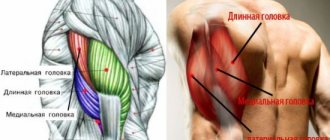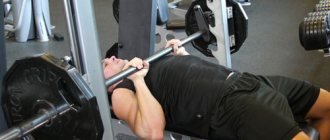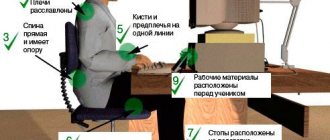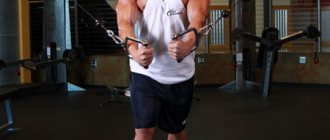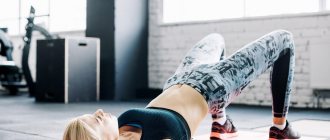Introduction
Triceps are a part of the body that many unreasonably consider to be the main one along with biceps and often spend too much time training them, forgetting about other muscle groups. You can often see guys in the gym who pump their arms two or even three times a week, stroking their pride with the misconception that “the more often you pump, the faster you will grow.” But we are not talking about them now.
In this article we will look at the work of the triceps muscle, whose task is to extend the elbow joint. It consists of three sections: the lateral head, the medial head and the long head of the triceps. As we already understood, the triceps are needed to extend the arms at the elbows. It is partially assisted by the elbow muscle. Accordingly, triceps training consists of all kinds of arm extensions. It is precisely this set of triceps exercises that we will consider below.
Contraindications for training
I do not recommend training triceps if you experience pain in your elbows or shoulder joints during exercise. You should not work with weights if you have arthritis, arthrosis and osteoporosis of the elbow and shoulder joints.
You need to approach exercises with caution if you have osteochondrosis, curvature, hernias and pain in the spine. For these diseases, lifting weights while standing or sitting on a bench should be completely avoided.
You should cancel training if you have elevated body temperature, cough, runny nose or other signs of a cold, including general weakness or malaise.
Close grip bench press
This triceps exercise involves the upper sections of all triceps heads, the upper chest and the front deltas. This is a basic exercise that develops strength, volume and density. Recommended for everyone, from beginner to master at the very beginning of triceps training.
Exercise technique
1. Lie down on the bench so that the barbell is at eye level. The head, shoulders and buttocks are pressed against the bench, the back is slightly rounded at the lower back, the feet are wider than the shoulders and rest on the floor. 2. Grasp the bar with a grip so that the distance between your palms is narrower than your shoulders. 3. Having removed the bar from the supports, the arms should be straightened, but not locked at the elbows, the elbows turned towards the legs. The bar should be above the middle of your chest. 4. Taking a deep breath, lower your elbows straight down. As soon as the bar touches your chest, exhale and press the bar upward powerfully. 5. Lower the barbell at a slow or moderate pace. You need to squeeze it from the chest at a moderate or fast pace. 6. Don't pause at the bottom. As soon as the bar touches your chest, immediately press it up.
Technique tips
- It is recommended to do this exercise first, since the working weight in it is much higher than in other triceps exercises.
- Always before removing the bar from the supports, make sure that the grip of each palm is at an equal distance from the center of the bar, otherwise it will be difficult to balance it.
- There is no need to linger at the bottom point. Such a delay will immediately shift the emphasis of the load from the triceps to the pectoral muscles, which will reduce the effectiveness of the exercise.
- Holding your breath helps not only to firmly fix the position of the body on the bench, but also helps to develop significantly greater force during the press.
- There is no need to arch your back while pressing. Firstly, this does not increase the effectiveness of the exercise in any way, and secondly, it is dangerous due to spinal injury.
- A grip that is too narrow will cause you to flare your elbows out to the sides at the bottom. This reduces the load on the triceps and disrupts the exercise technique.
- The longer the bar, the more difficult it is to balance its weight. If possible, it is recommended to perform the exercise with the bar as short as possible.
- To make it easier for you to choose the right grip, be guided by the notches on the bar. This way you don’t have to search for the optimal position of your palms every time.
- Always watch your elbows and do not turn them outward. In the starting position, they need to be turned towards the legs and movements must be made exclusively along the body.
- The most effective is the wide arc barbell press. At the lowest point the bar touches the solar plexus, at the top point the bar is at neck level.
Lifting the barbell for triceps in a lying position.
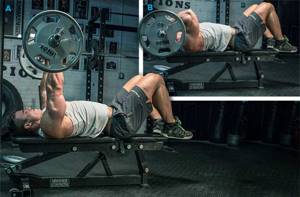
A more lightweight way to perform the French press, as all the stress on the body is removed. In this case, the triceps barbell lift is performed while lying down, and we hold our hands directly above the pectoral muscles. We lower our elbows and raise them. The arms are straight, the weights are not very heavy.
Know that the muscles will grow, not only due to the increase in the weight of the projectile, but also due to the development of endurance in them. It is better to start with light weights so that they begin to get used to the isolating load, and then move on to heavier ones. But of course, start doing exercises only after a good warm-up, otherwise injury is possible.
Dips

This triceps exercise targets all three triceps heads, especially the lateral part. This is a basic exercise used to increase the mass and thickness of the triceps. Recommended for everyone, from beginner to experienced athlete starting triceps training
Exercise technique
1. Approach the horizontal bars, grab the handrails with your hands and push off the floor, or step off the step to the starting position. 2. In the starting position, the body weight is supported by the hands. The body is straightened, arms are straight, elbows are directed back. Legs slightly bent at the knees. The head looks forward. 3. Inhale and bend your elbows, slowly lower yourself between the bars. At the bottom point you should feel your triceps tense as much as possible. 4. Having dropped to the bottom point, immediately, without delay, return to the starting position. Your arms need to be fully straightened, but not to the point of locking at the elbow joints. 5. You can exhale after passing the most difficult section of the amplitude. Don't linger at the top point either. Inhale and lower yourself down.
Technique tips
- The exercise engages the pectoral muscles only at the bottom of the movement, and not throughout the entire amplitude, so it makes no sense to include it in chest training.
- The more you lean your body forward at the bottom, the more your pecs are involved in the work. Try to keep your back vertical throughout the entire approach.
- The head should look straight ahead at all times. By tilting your head forward, you also provoke a rounding of the back and a forward tilt of the body, which is undesirable.
- Keep your elbows locked throughout the approach. By moving them apart, the load is removed from the triceps and the risk of dislocating the shoulder joint increases.
- Choose a machine with parallel bars at shoulder level. Bars that are too wide will shorten the range of motion and reduce the load on the triceps.
- Choose a machine with parallel parallel bars. If the bars in the grip zone expand, it will force you to spread your elbows out to the sides, no matter how hard you try.
- To maintain maximum tension in the triceps and achieve effective contraction of all muscle fibers, do not straighten your arms until your elbows lock.
- Do not swing your body, helping yourself to rise from the bottom point to the top. Rocking push-ups almost completely reduce the effectiveness of the exercise.
- If your level of training does not allow you to perform the exercise on your own, use the Gravitron simulator, a rubber expander, or the help of a partner.
- Once you have fully mastered the technique of performing the exercise, you can begin to use a weight belt and add additional weight to it.
Reverse push-ups
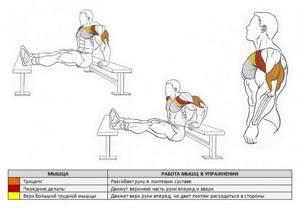
This triceps exercise targets all three triceps heads, especially the medial part. This is a basic exercise used to increase the mass and thickness of the triceps. Recommended for everyone, from beginner to experienced athlete at the beginning of triceps training.
Exercise technique
1. Move two benches towards each other so that they are parallel. Approximately one meter apart. 2. Sit across one bench in the center and clasp its edge with your palms shoulder-width apart. Elbows point back. Then place your heels on another bench. 3. Arms straight, move your pelvis forward a little so that it hangs freely over the edge of the bench. Legs are straightened, toes pointing up. The head looks forward. 4. Inhale and bend your elbows, slowly lower yourself between the benches. At the bottom point you should feel your triceps tense as much as possible. 5. Having dropped to the bottom point, immediately, without delay, return to the starting position. Your arms need to be fully straightened, but not to the point of locking at the elbow joints. 6. You can exhale after passing the most difficult section of the amplitude. Don't linger at the top point either. Inhale and lower yourself down.
Technique tips
- The exercise engages the pectoral muscles only at the bottom of the movement, and not throughout the entire amplitude, so it makes no sense to include it in chest training.
- Keep your elbows locked throughout the approach. By moving them apart, the load is removed from the triceps and the risk of dislocating the shoulder joint increases.
- In the starting position, the grip on the bench should be no more than shoulder width. Otherwise, a grip that is too wide will cause you to twist your elbows.
- The head should look straight ahead at all times. By tilting your head forward, you also provoke a rounding of your back, which is undesirable.
- To maintain maximum tension in the triceps and achieve effective contraction of all muscle fibers, do not straighten your arms until your elbows lock.
- If your fitness level does not allow you to do push-ups with your feet on a bench, try an easier variation with your feet on the floor. This option is easier, but also less effective.
- Once you have fully mastered the technique of performing the exercise, you can begin to use additional weights that your partner will place on your lap.
French bench press

This triceps exercise targets the long head, especially the lower part. A formative exercise, used to lengthen and thicken the lower edge of the triceps. Recommended for everyone, from beginner to expert at the beginning of triceps training.
Exercise technique
1. Take an EZ bar (or W bar) and load the bar with the desired weight. Place it on the racks of a French press bench. If there is no special bench, choose a regular one. 2. In the case of a regular horizontal bench, you sit on the edge of it, take the barbell from the floor and place it on your thighs. Then lie down and take your starting position. 3. In the starting position, the body lies on a bench, legs are spread wide, feet resting on the floor. The barbell is at eye level with arms outstretched. 4. Take a deep breath and, holding your breath, slowly bend your elbows. At the lowest point, the bar should drop to your forehead. 5. As soon as the bar reaches its lowest point, immediately, without delay, return it to its original position with straightened arms. 6. You can exhale after overcoming the most difficult section of the amplitude. Don't linger at the top point either. Inhale and continue the exercise.
Technique tips
- The optimal width and grip angle is determined by the curved bar. The grip should be slightly narrower than the shoulders. The hands should be at a distance of the thumbs.
- Significant weight in the exercise is useless. A barbell that is too heavy at the bottom will pull your elbows forward, which will significantly reduce the effectiveness of the exercise.
- The key to the entire exercise is keeping your elbows still. At the starting point of the exercise, fix them until the end of the approach.
- In this exercise, maximum contraction of the triceps can be achieved only by fully straightening the arms at the top point of the amplitude.
- Holding your breath allows you not only to stabilize the body on the bench, but also makes it possible to develop a much more powerful force.
- You should not raise your feet on the bench. This will significantly reduce the body's stability. You risk losing your balance, falling off the bench and getting injured.
- If you do not have the opportunity to use a curved bar, a straight bar will do just fine. However, it is less preferable because it turns the elbows out to the sides.
- A variation of the exercise with dumbbells is possible. This will slightly complicate the exercise, since each hand will work independently, which, however, will only work to your advantage.
Seated French press
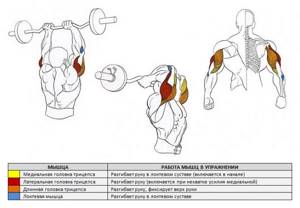
This triceps exercise with a barbell uses the long head of the triceps, especially its lower edge. A formative exercise, used to detail the long head of the triceps. Recommended for advanced and more experienced athletes in the middle of a triceps workout.
Exercise technique
1. Take an EZ bar (or W bar) and load the bar with the desired weight. Sit on a bench with an upright back or raise the back of an incline bench to 90 degrees. 2. Take the barbell with a narrow grip, preferably at the bend, and lift it so that at the top point the bar is directly above your head. 3. In the starting position, the arms with the barbell are fully straightened. The back is straight, the trapezius is pressed against the back. The legs are spread wide and the feet rest on the floor. 4. Take a deep breath and, holding your breath, slowly bend your elbows. At the lowest point, the bar should be at the level of the back of the head. 5. Do not linger at the bottom point and immediately return the bar to its original position. You can exhale after overcoming the most difficult section of the amplitude. 6. Don’t linger at the top point either. As soon as the bar returns to its starting position, inhale and continue the exercise.
Technique tips
- Keep your core muscles tense throughout the entire approach. This way you will maintain the natural curve of the spine and will not round your back.
- Throughout the entire approach, the elbows are fixed in one position and motionless. All movement occurs exclusively in the elbow joints.
- In this exercise, maximum contraction of the triceps can be achieved only by fully straightening the arms at the top point of the amplitude.
- For this exercise, the EZ bar is preferable. A straight bar causes you to flare your elbows due to excessive stress on your wrists.
- Significant weight in the exercise is useless. A barbell that is too heavy at the bottom will pull your elbows forward, which will significantly reduce the effectiveness of the exercise.
- The exercise places high demands on the flexibility of the shoulder joints. If they are poorly developed in you, it is not recommended to perform it.
- During the exercise, do not bring your elbows forward. This immediately transfers the load from the triceps to the spine, which can lead to injury.
- A variation of the exercise with one dumbbell is possible, when you hold it with both hands. It is suitable as an alternative to the barbell press, since you do not have to balance the weight.
Goal 4: working out the lateral head
The largest of the three heads, the lateral one, is the farthest from the center and forms the outer contour of the arm. Shifting your focus to the lateral head is a great way to add variety to your triceps training or tighten up a lagging triceps muscle.
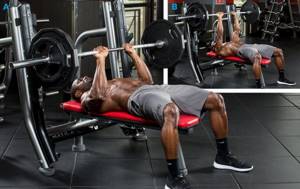
You can work the outer head with multi-joint or single-joint movements, but exercises that keep your arms close to your sides, especially with an overhand grip, work best for this purpose.
Explanation of the training.
- Warm-up sets do not count; do them as much as necessary, but never bring them to muscle failure.
- Choose a weight that allows you to reach failure within your intended rep range.
- If you have a partner, do some forced reps on your heaviest set(s) on the first two exercises. If you don't have a partner, get close to muscle failure and use drop sets on the last set of each exercise.
Lateral head of triceps training
- Close grip bench press - 3 sets of 8 reps (rest 60-90 sec.)
- Dips - 3 sets of 10 repetitions, during movement try to avoid leaning your torso forward and make sure that your elbows do not go to the sides (rest 60-90 sec.)
- French press with EZ barbell on a reverse incline bench - 3 sets of 10 reps (60 sec rest)
- Bent-over dumbbell lifts - 3 sets of 12 reps (rest 60 seconds)
French press in the simulator
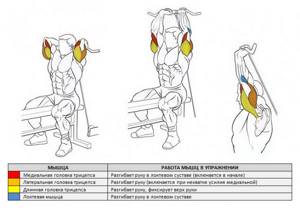
This triceps exercise targets the long head of the triceps. An isolating exercise, used to clearly separate the triceps from the biceps. Recommended for everyone from beginner to experienced athlete in the middle of a triceps workout.
Exercise technique
1. Set the machine to the desired weight and attach the curved handle to the lower pulley cable. Move the flat bench towards the machine. 2. Take the handle at a distance of your thumbs, turn around, placing it behind your head, and sit on the bench with your back to the machine. 3. In the starting position, your arms are bent at the elbows behind your head. The back is straight, the legs are spread wide and the feet rest on the floor. The gaze is directed ahead. 4. Take a deep breath and, holding your breath, slowly straighten your elbows. At the top point, the arms are fully straightened and the handle is directly above the head. 5. You can exhale after overcoming the most difficult section of the amplitude. As soon as the handle is at the top point, return it to its original position. 6. You shouldn’t linger at the bottom point either. As soon as the handle drops behind your head, immediately without delay, change the direction of movement upward.
Technique tips
- Keep your core muscles tense throughout the entire approach. Once you relax your muscles, it will immediately cause your back to round, which can lead to injury.
- Maximum contraction of the long head of the triceps and olecranon muscles can only be achieved if the arms are fully extended at the top point.
- Locking your arms at the elbow joint increases the contraction of the triceps, but do not practice it with heavy weights, otherwise it will lead to injury.
- The cornerstone of the exercise is keeping your elbows still. They must be fixed throughout the entire approach.
- Do not raise or lower your head during the entire approach. Raising your head can cause you to fall back, while tilting your head can cause your back to round.
- There is no point in using too much weight in the exercise. First of all, hone the technique of performing the exercise, then increase the working weight.
- A variation of the exercise with a rope is possible. This will complicate it somewhat, since the rope allows you to turn the hand throughout the entire amplitude.
Overhead dumbbell extensions
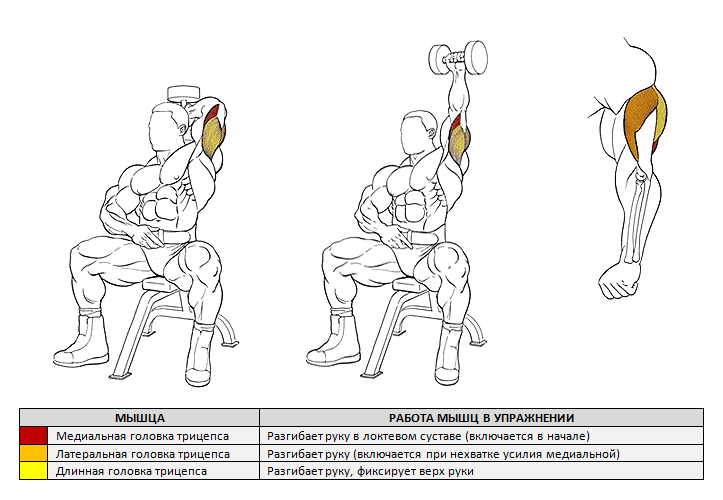
This triceps exercise targets the top and middle of all three triceps heads. An isolating exercise, used to highlight the volume of the upper triceps. Recommended for advanced and more experienced athletes to complete their triceps training.
Exercise technique
1. Select a dumbbell of the desired weight and sit on a bench. Place your hand with a dumbbell behind your head so that your elbow looks vertically up and your palm looks forward. 2. In the starting position, your back is straight, your legs are spread wide and your feet rest on the floor. One hand holds a dumbbell behind your head, the other on your belt. The head looks forward. 3. Take a deep breath and, holding your breath, straighten your arm and lift the dumbbell. At the top point, the arm should be fully straightened. The palm faces forward. 4. You can exhale after overcoming the most difficult section of the amplitude. Then immediately, slowly return your hand to its original position. 5. At the lowest point, the dumbbell is at the level of the back of the head. You shouldn't linger in this position either. Inhale and continue the exercise. 6. Perform the specified number of repetitions for one hand, then change hands and repeat the same steps for the other hand.
Technique tips
- Keep your back straight throughout the entire approach. Tilt of the body will cause the back to round, which can lead to injury to the spinal discs.
- Throughout the entire approach, the elbow should be fixed in one position. To do this, you can press your hand to your head to avoid unnecessary rocking.
- If you still find it difficult to keep your arm still, grab the triceps of your working arm with your other hand, pressing it to your head.
- The hand with the dumbbell should not be in the same plane as the head, but slightly behind it, otherwise you will lower the dumbbell onto your head, which is contrary to the technique.
- Straightening the arm until the elbow joint is locked in this exercise does not make sense, since at the top point the load goes from the triceps to the elbows.
- For the comprehensive development of the triceps brachii muscle, it is recommended to alternate the angle of rotation of the forearm. This will allow you to work your triceps as efficiently as possible.
- To pump the lateral head of the triceps, at the moment of straightening the arm, you should try to turn the dumbbell as far outward as possible - away from you.
- To pump the medial head of the triceps, at the moment of straightening the arm, you should try to turn the dumbbell as much as possible inward - towards yourself.
- To pump the long head of the triceps, the palm should look exclusively forward throughout the entire range of motion.
- Regardless of whether you rotate your forearm or not, do not bend or straighten your wrist. It must remain fixed until the end of the approach.
- There is no point in using too much weight in the exercise. It will prevent you from working at full range and will significantly reduce the effectiveness of the exercise.
The best exercises for pumping up the triceps
We have prepared a list of the most effective movements for the mass and relief of the triceps brachii muscle and divided them into two groups.
Arm extension on the upper block
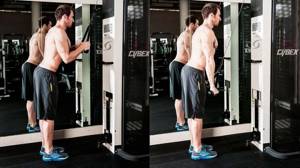
Grasp the rope handle fixed to the upper mount. Palms should face each other. Pull the handle to lift the weight, keeping your elbows close to your body. Keeping your torso still, extend your arms down and out to engage your triceps, then slowly return to the starting position. Can be performed effectively by women.
Close grip bench press

Lie down on a horizontal bench, grab the barbell with an overhand grip, your hands should be about 20 cm apart. Plant your feet firmly on the floor and press the barbell up with a powerful movement, then slowly lower it back until it is directly above your sternum.
Dips

Rest your arms on the parallel bars and hold a light dumbbell between your feet or attach a weight to your belt. To engage your triceps, keep your torso vertical. Bring your arms close to your body, bend and lower until your arms are at the correct 90-degree angle, then forcefully return to the starting position. Works the triceps well.
Triceps push-ups
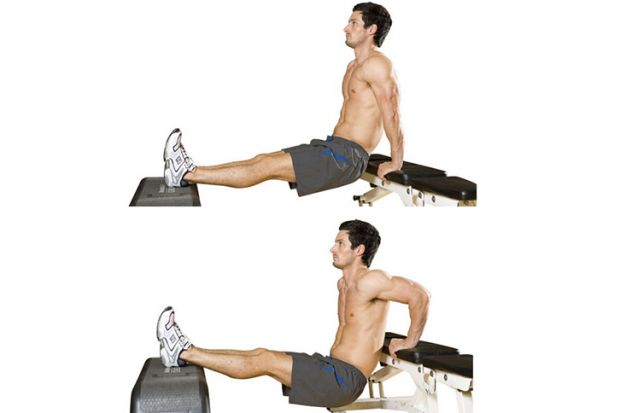
Sit on the edge of a bench with your feet on another bench opposite. Transfer your body weight to your hands, palms should rest on the edge of the bench, fingers pointing forward. Lower your body until your arms are at an angle of approximately 90 degrees, then return to the starting position with a powerful movement.
Close grip push-ups
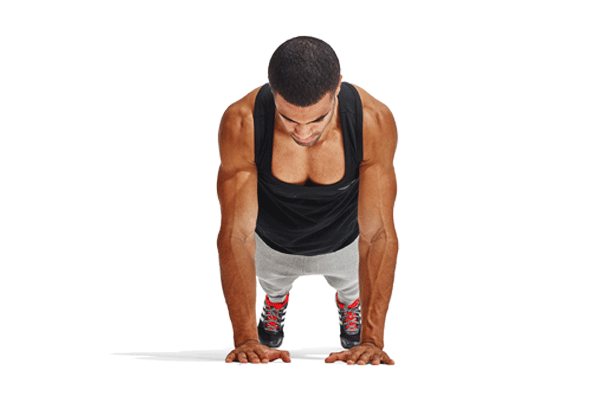
Perform a standard push-up, but your palms should be narrower than shoulder width. Lower yourself until your chest touches your arms, then rise until your arms are fully extended. This way you will perform a full range of motion and work your pectoral muscles and triceps with high efficiency.
French press with dumbbells
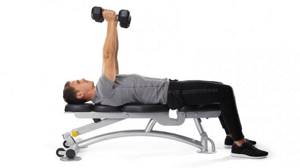
Lie down on a bench, take a light dumbbell in each hand, arms should be straightened vertically upward. Keep your shoulders still and bend your elbows so that the weights drop to the sides of your head, then return your arms to the starting position.
Standing triceps extension
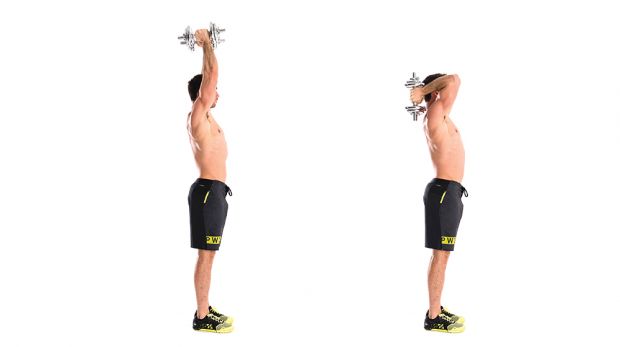
Stand straight, lift the dumbbell above your head, keep your hand close to your ear. Keep your shoulder still, bend your arm to bring the dumbbell behind your head, then straighten your elbow and return your arm to a vertical position.
Pulling the block from behind the head

Here we will need a cable trainer again, but this time stand with your back to the mount. Grasp the handles with your palms facing each other and move away from the machine to lift the weight. Your arms should be behind your head, your elbows tense, straighten them as if you were holding a soccer ball with both hands, then return to the starting position. The exercise is highly effective.
Arm extension with elastic band
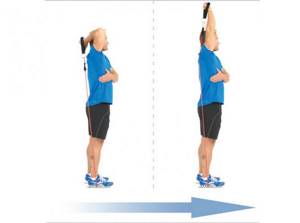
Second option for performing the exercise:

Grab the elastic band with one hand behind your head, hold the other end of the band with your other hand behind your back, and press your hand against your body. Keep the shoulder of your upper arm motionless, straighten your elbow, overcoming the tension of the band.
Bent over arm extension with dumbbell

This triceps exercise with dumbbells works all three triceps heads, especially the lower part. The exercise is isolating and is used to give triceps symmetry and relief. Recommended for everyone, from beginner to experienced athlete to complete their triceps workout.
Exercise technique
1. Stand next to a bench and lean on it with one hand. Take a dumbbell in your other hand. Spread your legs wide so that your back is parallel to the floor. 2. Take a dumbbell with a neutral grip - palm facing the bench. Raise and fix your arm so that the angle between your shoulder and forearm is 90 degrees. 3. Take a deep breath and, holding your breath, straighten your arm at the elbow. At the top point, the arm should be completely straightened to be horizontal with the floor. 4. You can exhale after overcoming the most difficult section of the amplitude. Do not linger at the top point and immediately return the dumbbell to its original position. 5. As soon as the forearm takes a vertical position and the angle at the elbow is again equal to 90 degrees, immediately, slowly inhale and continue the exercise. 6. Perform the prescribed number of repetitions for one arm, then change hands, stand on the other side of the bench and repeat the same steps for the other arm.
Technique tips
- Throughout the entire approach, the body should be parallel to the floor. The higher you raise your body, the smaller the amplitude will be and the lower the effectiveness of the exercise will be.
- Holding your breath during the exercise helps keep the body in a fixed position and allows you to develop significantly greater force.
- Maximum contraction of the triceps can only be achieved if the shoulder is parallel to the floor and the arm with the dumbbell is fully extended at the top point.
- There is no point in using too much weight in the exercise. It will force you to swing the dumbbell, throwing it by inertia, and will also not allow you to work at full amplitude.
- At the lowest point, the wrist should be strictly under the elbow. By bending your elbow more, you will swing the dumbbell by inertia, which will take the load off your triceps.
- You can achieve maximum contraction of the long head of the triceps by first fully extending your arm, and then raising the straightened arm as high as possible.
- The elbow is fixed in one position throughout the entire approach. By lowering, raising or moving it to the side, you reduce the effectiveness of the exercise.
- For comprehensive development of the triceps, perform the exercise by turning your forearm inward (toward you) or outward (away from you) in different approaches.
- A variation of performing the exercise with both hands at the same time is possible. This is a more difficult option, since you need to keep your torso suspended in a horizontal position.
Arm extensions in the simulator

This triceps exercise targets the lateral as well as the long head of the triceps. An isolating exercise designed to highlight the lateral part of the triceps. Recommended for everyone from beginner to experienced lifter at the end of a triceps workout.
Exercise technique
1. Set the desired weight on the machine and attach the cable handle to the cable of the upper pulley. Take half a step back and grab the rope with a parallel grip so that your hands are facing each other. 2. In the starting position, the body is slightly inclined towards the machine, with your elbows slightly forward. The back is straight, one leg is slightly in front of the other, the load is raised from the supports, the cable is taut. 3. Take a deep breath and, holding your breath, extend your arms downwards. At the lowest point, the hands should be turned out, and the arms should be slightly spread towards the hips. Palms face the floor. 4. You can exhale after overcoming the most difficult section of the amplitude. Do not linger at the bottom point and return your hands to their original position. 5. As soon as the hands are at the top point of the amplitude, also, without delay, change the direction of their movement and continue the exercise.
Technique tips
- The position of the elbows is extremely important in this exercise. It must be motionless. The elbows are fixed at one point throughout the entire approach.
- To achieve maximum contraction of the triceps, in the starting position you need to tilt your body slightly forward and bring your elbows beyond the line of the body.
- When lowering the rope down, the hand should turn not due to the force of the wrists, but solely due to the rotation of the forearms. The wrists are fixed throughout the approach.
- Turning the hand to the lowest point of amplitude allows you to achieve maximum contraction of the triceps, which increases the effectiveness of the exercise.
- The body position throughout the entire approach should be motionless. By tilting your body forward or back, you take the pressure off your triceps.
- Too heavy a weight in an exercise will do no good. First of all, learn the technique of performing the exercise, then increase the working weight.
- A variation of the exercise with a straight or curved handle is possible. Different widths and grip angles on the bar allow you to work your triceps from different angles
Triceps extensions one arm at a time
Grasp the handle with one hand with a reverse grip. Press your elbow to your ribs, keep your forearm parallel to the floor. Without changing the position of your upper arm, extend your elbow and contract your triceps. At the bottom point, straighten your arm, concentrate on the peak contraction of the triceps, and then return to the starting position.
This grip helps you concentrate more on the work of the medial triceps. The exercise is great for detailing.
Use it at the end of your workout: by this point, the triceps will already be tired, and then you will feel the full effect of this exercise.
Triceps training while gaining muscle mass
- Imitation of push-ups on parallel bars in the simulator: 4–6 sets of 10–15 repetitions.
- Triceps extensions on the upper block: 4-6 sets of 10-15 reps.*
- Triceps extensions with cable handle: 4-6 sets of 10-15 reps.*
- Single arm triceps extensions: 4-6 sets of 10-15 reps.
* On the last set, do 2-3 dropsets.
Useful article: “How many times a week should you exercise”
Reverse grip arm extension

This triceps exercise targets the lateral and medial heads of the triceps. An isolating exercise, used to detail and outline the shape of the triceps. Recommended for advanced and more experienced athletes at the end of a triceps workout.
Exercise technique
1. Set the machine to the desired weight and attach the single handle to the upper pulley cable. Stand next to the machine so that your working arm is in the same plane as the block. 2. Take half a step back and grab the handle with a reverse grip. In such a way that the palm faces itself, and the arm remains bent at the elbow. 3. In the starting position, the body is slightly inclined towards the machine, the back is straight, one leg is slightly in front of the other, the load is raised from the supports, the cable is taut. 4. Take a deep breath and, holding your breath, extend your arm downward. At the bottom point, the arm should be fully straightened. 5. You can exhale after overcoming the most difficult section of the amplitude. Then, immediately, without delay, return the handle to its original position. 6. At the top point, the handle should be at chest level. As soon as the brush rises to the top point, immediately change the direction of movement. 7. Perform the specified number of repetitions for one hand, then change hands and repeat all the same manipulations with the other hand.
Technique tips
- Holding your breath throughout the entire approach will help stabilize the body and allow you to develop significantly greater force.
- The working arm is fixed at the elbow throughout the entire approach. Do not move your elbow back, forward or to the side. This will significantly reduce the effectiveness of the exercise.
- By moving your elbow to the side, you shift the load to the long head of the triceps, which in turn removes the load from the working - lateral head of the triceps.
- Since the exercise is performed with one hand, significant weight will not be needed here. It will not allow you to work at full amplitude.
- A variation of the exercise from the lower block is possible. You tilt your body 90 degrees, and the same movements will allow you to contract the medial head of the triceps as much as possible.
- A variation of the two-handed reverse grip is possible. A curved handle is suitable for this. It will allow you to focus the load on the medial and lateral heads of the triceps.
Triceps anatomy
TO

As the name suggests, “three” implies that this muscle group consists of three heads - lateral (outside), medial (in the center) and long (inside). Medial is the shortest. It is this that forms the desired horseshoe-shaped triceps.
Most of the triceps muscle is located on the humerus, where all three heads connect. For this reason, in order to maximally work these muscles, it is necessary to perform each exercise very well.
Afterword
The purpose of our article was to describe a set of triceps exercises. Without exception, all the exercises given here can be considered the most effective for training triceps. Of course, this list cannot be called the most complete, since the arsenal of exercises is replenished with different variations of exercises every year. However, the exercises we described in this article are more than enough to build complete training programs and add variety to the training process.
